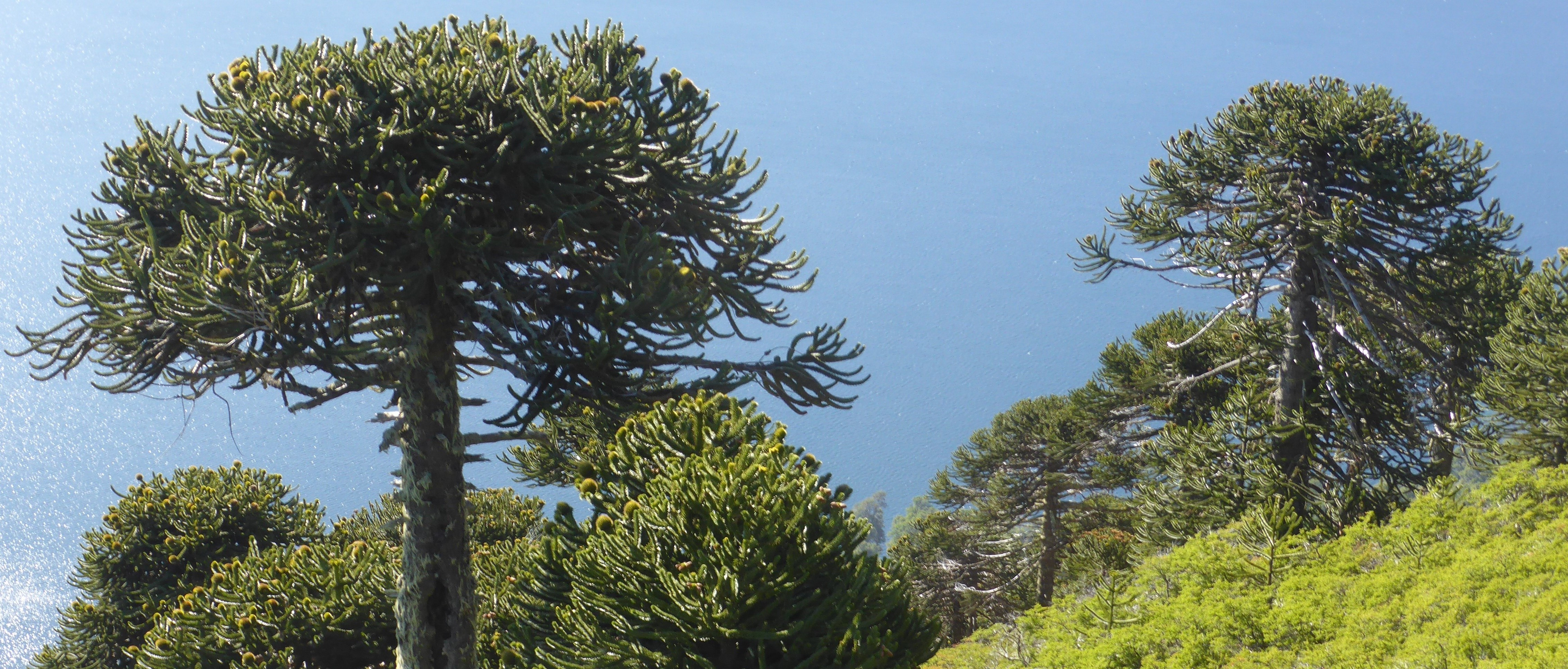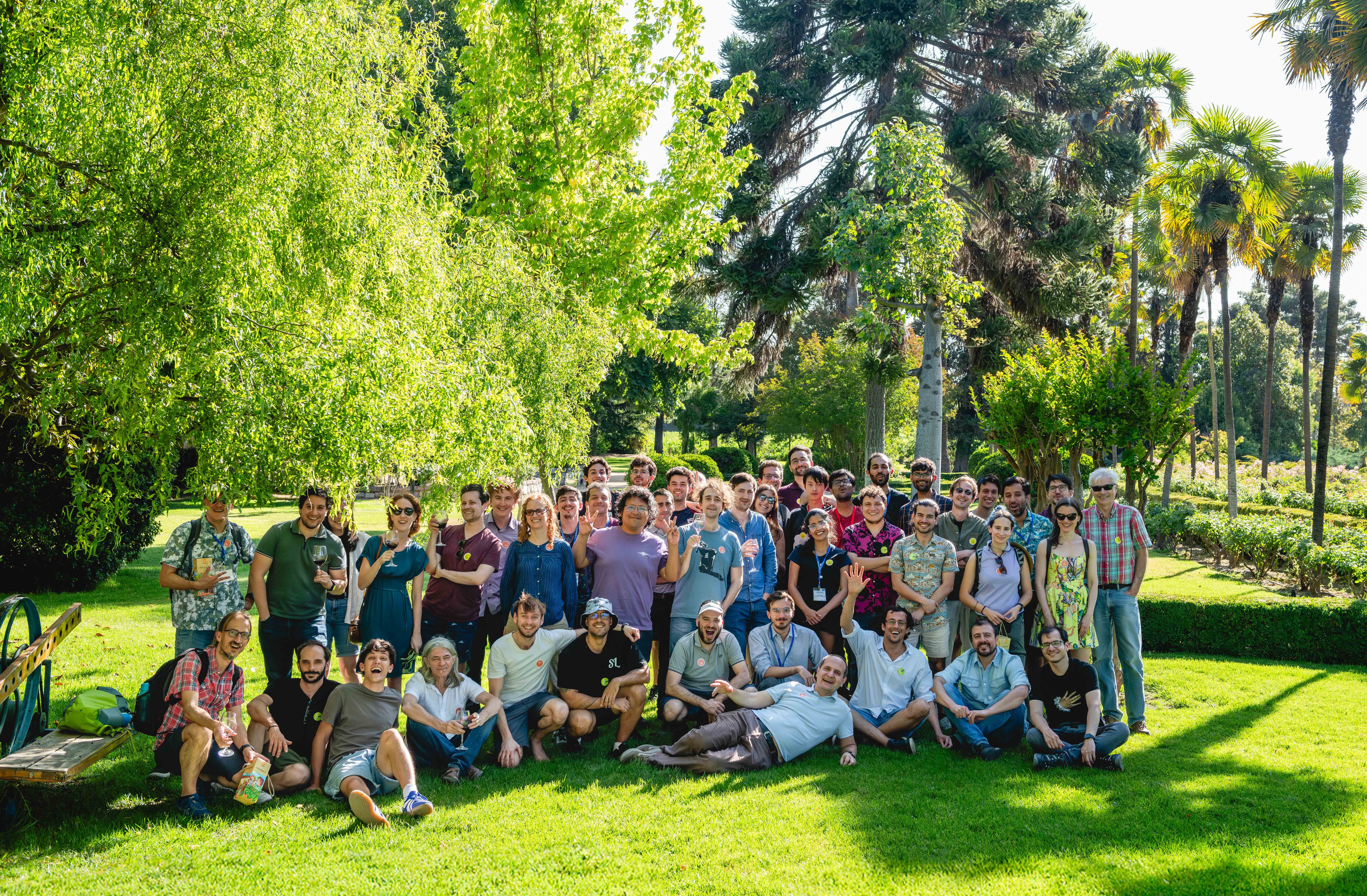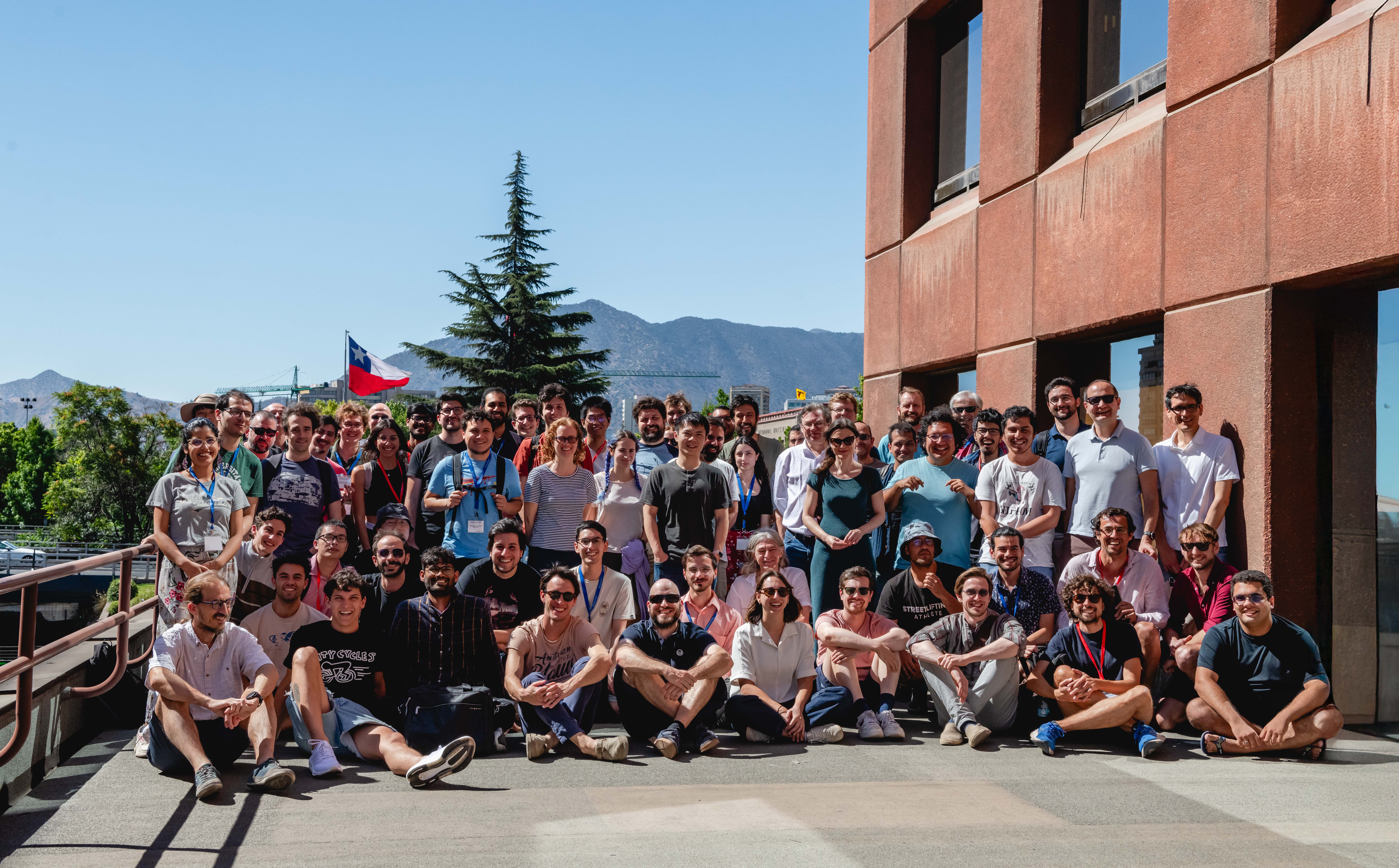
Conference
About
The conference will gather experts in arithmetic and p-adic geometry. They will share their latest results to a broad audience beyond specialists in their precise area.
Speakers
- Denis Benois (Institut de Mathématiques de Bordeaux, France)
- Adel Betina (University of Vienna, Austria)
- Pierre Colmez (Sorbonne Université, France)
- Xenia Dimitrakopoulou (Université d'Aix-Marseille, France)
- Mladen Dimitrov (Université de Lille, France)
- Natalia Garcia-Fritz (Pontificia Universidad Católica, Chile)
- Lennart Gehrmann (Bielefeld University, Germany)
- Luis Lomelí (Pontificia Universidad Católica de Valparaíso, Chile)
- Dino Lorenzini (University of Georgia, USA)
- Giancarlo Lucchini Arteche (Universidad de Chile, Chile)
- Siddharth Mathur (Pontificia Universidad Católica, Chile)
- Isabella Negrini (University of Toronto, Canada)
- Héctor Pasten (Pontificia Universidad Católica, Chile)
- Claus Sorensen (UC San Diego, USA)
- Gonzalo Tornaria (Universidad de la República, Uruguay)
- Eric Urban (Columbia University, USA)
- Jeanine Van Order (Pontifícia Universidade Católica do Rio de Janeiro, Brasil)
Schedule
| Time | Monday | Time | Tuesday | Wednesday | Thursday | Friday |
|---|---|---|---|---|---|---|
| 09:30-10:00 |
Welcome
|
09:30-10:30 |
Mladen Dimitrov
Uniform irreducibility of Galois action on the \(p\)-primary part of Abelian \(3\)-folds of Picard type
Abstract: Half a century ago Manin proved a uniform version of Serre’s celebrated result on the openness of the Galois image in the automorphisms of the \(p\)-adic Tate module of any non-CM elliptic curve over a given number field. In a collaboration with D. Ramakrishnan we provide first evidence in higher dimension. Namely, we establish a uniform irreducibility of Galois acting on the \(p\)-primary part of principally polarized Abelian \(3\)-folds with multiplication by an imaginary quadratic field having no CM factors, under a technical condition which is void in the semi-stable case. |
Luis Lomelí
Holomorphy of local and global Langlands-Shahidi \(L\)-functions in positive characteristic
Abstract: The first part of the talk will focus on representation theoretic aspects of \(p\)-adic reductive groups in characteristic \(p\). We settle Shahidi’s tempered \(L\)-function conjecture in general, which states that local Langlands-Shahidi \(L\)-functions are holomorphic for \(\mathrm{Re}(s){\gt}0\), and we prove the standard module conjecture as a consequence. For the split classical groups, we prove a useful non-unitarity criterion for unramified principal series representations. These local results are obtained in collaborative work with del Castillo and Henniart. The second part of the talk will be on globally generic cuspidal automorphic representations and their \(L\)-functions. For the classical groups over function fields, we discuss holomorphy in the region \(\mathrm{Re}(s){\gt}1\). Furthermore, we relate the holomorphy property to Langlands functoriality and isobaric sums. |
- |
Siddharth Mathur
Formal GAGA for Brauer classes
Abstract: Deformation theory studies the variation of geometric data as a variety moves in a family. In this talk, we will introduce some new deformation theoretic methods and use them to address a question of Grothendieck from the 1960s: how does the Brauer group of a family compare with that of the various thickenings of a special fiber. We will begin by probing a seemingly simpler question concerning the infinitesimal behavior of invertible sheaves and end by using this to give a comprehensive answer to Grothendieck's question. This is joint work with Andrew Kresch. |
| 10:00-11:00 | Pierre Colmez
Completed cohomology and group cohomology Abstract: We will explore the relation between Emerton's completed cohomology and the cohomology of arithmetic groups acting on spaces of functions on adelic groups. |
10:30-11:00 | Posters with ☕🍪 |
Posters with ☕🍪 |
Posters with ☕🍪 |
Posters with ☕🍪 |
| 11:00-11:30 | ☕🍪 | 11:00-12:00 |
Dino Lorenzini
Torsion and exceptional units
Abstract: Associated with an abelian variety \(A/K\) over a number field \(K\) is a finite set of integers greater than \(1\) called the local Tamagawa numbers of \(A/K\). The ratio (product of the Tamagawa numbers)/|Torsion in \(A(K)\)| appears in the conjectural leading term of the \(L\)-function of \(A\) in the Birch and Swinnerton-Dyer conjecture, and we are interested in understanding, when \(A(K)\) has a non-trivial torsion subgroup, whether there are often cancellations in this ratio. When \(N\) is prime, let us call \(N\)-special an abelian variety \(A/K\) with a \(K\)-rational torsion point of order \(N\) and such that \(N\) does not divide the product of the Tamagawa numbers. We will show that the existence of an \(N\)-special elliptic curve \(E/K\) is intimately linked to the existence of exceptional units in the ring of integers of \(K\). When \(N {\gt} 2d+1\), we suggest that there exist only finitely fields \(K/\mathbb Q\) of degree d having (finitely many) \(N\)-special elliptic curves \(E/K\). The list of known \(N\)-special elliptic curves is surprisingly short when d is at most \(7\). |
Eric Urban
A control theorem and a construction of zeta elements in the super-singular case
Abstract: In a recent joint work with S. Iyengar, C. Khare and J. Manning, we use their notion of congruence modules in higher codimension to give a new construction of the bottom class of the rank \(d=[F:\mathbb Q]\) Euler system attached to nearly ordinary Hilbert modular forms for a totally real field \(F\) that I constructed a few years ago. In this talk, I will discuss the non ordinary case for elliptic cusp forms and the construction of Zeta elements in the exterior square of the Galois cohomology of adjoint modular Galois representations via an integral control theorem for the \(p\)-adic Hecke algebra in the supersingular case which replaces the classical control theorem in Hida theory used in that previous work. |
Claus Sorensen
Localization at a supersingular representation
Abstract: I will report on work in progress toward a better understanding of the localizing subcategories of the derived category of smooth mod \(p\) representations of \(\mathrm{GL}(2,\mathbb Q_p)\). After motivating the problem, as a sample result, I will produce examples of minimal localizing subcategories arising from supersingular representations. This makes heavy use of the \(p\)-adic local Langlands correspondence. |
Jeanine Van Order
\(p\)-adic interpolation of \(\mathrm{GL}(n)\)-automorphic periods in anticyclotomic extensions of CM fields
Abstract: I will present a new approach to studying families of central values of \(\mathrm{GL}(n)\)-automorphic \(L\)-functions in ring class towers of CM fields through two toric integral presentations — namely the Eulerian integral presentation and the Ichino-Ikeda Gan-Gross-Prasad conjecture. These integral presentations can be used to give two new constructions of \(p\)-adic interpolation series, as I will explain. If time permits, then I will also explain related open problems about congruence numbers, nonvanishing estimates, and the existence of corresponding Euler system constructions. |
| 11:30-12:30 | Gonzalo Tornaría
Computing paramodular forms. Abstract: The goal of this talk is to explain how to compute weight \(3\) (and higher) paramodular forms. After a brief introduction to paramodular forms, I will explain the relation between paramodular forms and orthogonal modular forms on definite quinary lattices, and how to compute the latter. |
12:00-14:00 | Lunch | Lunch Buses departure at 13:35 |
Lunch | Lunch |
| 12:30-14:30 | Lunch | 14:00-15:00 |
Héctor Pasten
Explicit Mordell for curves with automorphisms I
Abstract: In the direction of Mordell's conjecture, Mumford proved in \(1965\) a repulsion result for rational points on curves. Since then, the Mumford gap principle and its variations have played a central role in Diophantine approximation. I will discuss an explicit version that will be needed in a follow-up talk on the effective Mordell conjecture. This is joint work with N. Garcia-Fritz. |
Visit to the Viña Undurraga |
Isabella Negrini
A Shintani map for rigid cocycles Abstract: Rigid cocycles were defined in \(2017\) by Darmon and Vonk and give a promising framework to extend the theory of complex multiplication to real quadratic fields. They share striking parallels with modular forms, and their generalizations are the main ingredient in the emerging \(p\)-adic Kudla program.
In previous work I showed how to build a map from half-integral weight modular forms to rigid cocycles in the style of the Shimura lift. In this talk I will show how to construct a map going in the opposite direction, in the style of the Shintani lift. |
Denis Benois
On Iwasawa theory of critical \(p\)-adic \(L\)-functions
Abstract: We will discuss the formulation of the Main Conjecture of Iwasawa theory for \(\theta\)-critical \(p\)-adic \(L\)-functions of elliptic modular forms. This is a joint work with Kâzım Büyükboduk. |
| 14:30-15:30 | Lennart Gehrmann
Towards a Gross-Kohnen-Zagier theorem for plectic points
Abstract: Plectic points are tensors of \(p\)-adic points on elliptic curves that are conjectured to control the arithmetic of higher rank Mordell-Weil groups. Their construction crucially relies on the choice of an auxilliary quadratic CM extension of the base field, which is assumed to be a totally real number field. I will report on joint work with Michele Fornea and Martí Roset, in which we prove that the generating series of plectic points is a modular form of parallel weight \(3/2\) that is in Shimura correspondence with the Hilbert modular form attached to the elliptic curve in question. This generalizes the classic result of Gross-Kohnen-Zagier concerning the generating series of Heegner points on modular Jacobians. As a corollary, one deduces that the rational vector space spanned by plectic points is at most one-dimensional. |
15:00-15:30 | Posters with ☕🍪 |
- | Posters with ☕🍪 |
- |
| 15:30-16:00 | ☕🍪 | 15:30-16:30 |
Natalia Garcia-Fritz
Explicit Mordell for curves with automorphisms II
Abstract: One of the central problems in the theory of Diophantine equations is the effective Mordell conjecture. This important problem remains wide open despite some partial results. In this talk I will discuss the history of this problem and I will present a new result giving a completely explicit height bound for rational points on curves with enough automorphisms. This is joint work with H. Pastén. |
- |
Xenia Dimitrakopoulou
Anticyclotomic \(p\)-adic \(L\)-functions for Coleman families of \(U(n) \times U(n+1)\)
Abstract: In this talk, I will explain how \(p\)-adically interpolating the branching law for the spherical pair \((U(n),U(n) \times U(n+1))\) allows us to construct a \(p\)-adic \(L\)-function attached to Coleman families of cohomological automorphic representations of \(U(n) \times U(n+1)\). Using the recent proof of the unitary Gan–Gross–Prasad conjecture, I will demonstrate that this \(p\)-adic L-function interpolates the square root of the central critical L-value, including anticyclotomic variation. |
- |
| 16:00-17:00 | Giancarlo Lucchini-Arteche
Period-index problem and Serre’s Conjecture II for complete discretely valued fields
Abstract: The period-index problem deals with the relation between the period of a central simple algebra (that is, the order of its class in the Brauer group) and its index (that is, the size of the underlying division algebra). This problem is actually related with the remaining open cases of Serre's Conjecture II, which states that principal homogeneous spaces of semisimple simply connected linear algebraic groups should be trivial over fields of cohomological dimension \(2\). In this talk, I intend to give an idea of these two big problems and their relation. Then I will focus on complete discretely valued fields (with cohomological dimension 2). In this context, I will present a recent result with Diego Izquierdo stating that period and index coincide for p-torsion elements in the Brauer group, for any prime number p. As an application, we obtain that Serre's Conjecture II holds for these fields as well. |
- | - | - | - | - |
| 19:00 | Welcome reception at Bar Pipiolo | - | - | - | - | - |

